With over 40 years of masonry experience, owner John Machnicki brings his clients knowledge of both traditional European and vintage Chicago masonry in order to repair and restore homes to their original beauty.
Brick & Stone Restoration’s strategy for masonry work begins by thoroughly analyzing any problems, then recommending effective solutions, and finally, executing quality work. The combination of in-depth problem assessment with skillful repairs ensures the strength and beauty of the masonry of a vintage home.
-
Brick repairs and restoration are vital for maintaining the structural integrity and appearance of brick buildings. Factors like weathering, moisture, structural movements and lack of proper maintenance can lead to damages such as cracks, spalling, and brick and mortar deterioration.
-
Over time, factors such as weathering, pollution, moisture, and structural movements can cause damage like cracks, spalling, and erosion. Regular maintenance and restoration prevent further deterioration, ensuring the longevity of stone structures.
-
The facade of a building refers to the exterior, or front-facing, side of the structure, which is visible from the street or public areas. It is essentially the face of the building and plays a crucial role in defining its overall appearance and character.
Improper maintenance, specifically the application of hard cement mortar and water-vapor impermeable coatings such as synthetic paints, hard cement plaster, patches, and slurries contribute to the deterioration of the facade. Abrasive cleaning methods and rusted steel lintels and anchors further that deterioration.
-
Tuckpointing is the process of applying new mortar over the existing mortar joints. Properly done, tuckpointing restores the visual and physical integrity of the masonry. Improperly done, it not only detracts from the appearance of the building but may also cause physical damage to the masonry.
The concept behind the construction of old buildings is that moisture entering the wall should be able to evaporate. If an impervious layer, such as the hard cement mortar or plaster, is applied to old buildings, it traps dampness inside the structure, preventing water from evaporating. As the moisture content in the wall rises, the risk of masonry decay also increases.
-
A lintel is a horizontal beam (usually metal) placed over a masonry opening to support the weight of the masonry above.
It's essential for the joint between the steel lintel and the masonry to remain open to facilitate drainage. Painting, caulking, or covering this joint may lead to rusting of the lintel, causing structural problems. Rusting lintel can exert significant pressure on the masonry, leading to cracking and spalling of bricks at the corners of window or door openings where the lintel is embedded into the masonry.
-
Most old structures built before 1910 have brick or stone foundations. Under normal circumstances, any moisture entering the masonry wall should be able to evaporate. However, use of waterproofing materials, such as cement plasters, synthetic paints, and hard cement mortars hinders this process, leading to leaks, deterioration of foundation walls, brick, stone, and mortar.
-
A parapet wall is the top portion of the masonry wall that extends up past the plane of the flat roof.
Most common problems with the deterioration of parapet walls are caused by improper installation of the roofing membrane (completely covering the roof side of the parapet wall) and by tuckpointing with hard cement mortar. This traps moisture within the wall, preventing evaporation, and leads to masonry deterioration.
-
The exterior chimney, the part above the roof of a home, is a vulnerable masonry structure in any building – it is exposed to elements from all sides. Lack of maintenance and improper repairs using the wrong materials and methods leads to chimney deterioration.
-
Our masonry consulting services include:
Condition assessment - conducting thorough evaluations of masonry structures to assess their current condition, identifying existing issues, and determining causes of deterioration.
Recommendations for restoration - providing expert recommendations for restoration efforts, including appropriate repair methods, materials, and techniques.
Budget estimation - offering cost estimates and budgeting assistance for masonry repair and restoration projects.

